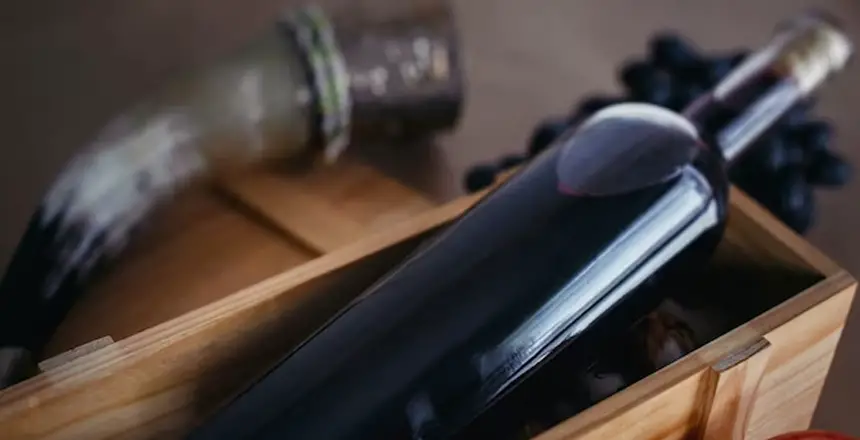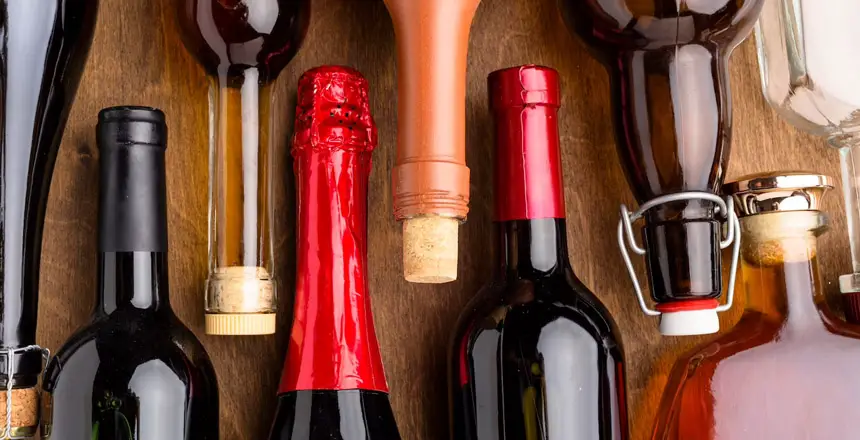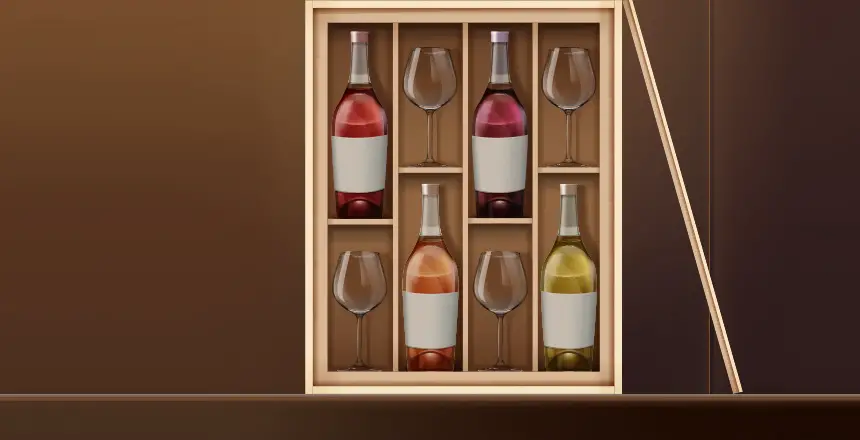Are you a connoisseur or a novice when it comes to wine? Do you often find yourself wondering, “How many liters are in a bottle of wine?” If so, then don’t worry.
You’re not alone! When it comes to wine, understanding the basics – such as how and why different bottles hold differing amounts of liquid – can be somewhat confusing.
Fortunately though, this blog post provides all of the information that you need to know in order to get smart on the topic. Read on to learn more about exactly how many liters come in a single glass and some additional interesting facts about working with bottles of wine.
How Many Liters are in a Standard Wine Bottle?

A standard wine bottle can hold approximately 750 milliliters, which is equivalent to about 25 fluid ounces or 0.75 liters of wine. This is a universal standard enforced by the International Organization of Vine and Wine as well as most countries around the world.
However, there are larger and smaller wine bottle sizes available that you may come across, such as a magnum that contains twice the amount of wine or a half bottle that has only 375 milliliters.
It’s important to note that different wine regions have their own traditional bottle shapes that may vary in size, but the volume usually remains the same. So next time you’re enjoying a bottle of wine, remember that a standard bottle size is just enough for about 4-5 glasses.
What are the Different Wine Bottle Sizes and How Many Liters are They?

In addition to the standard 750-ml bottle, there are a variety of other sizes and types of wine bottles that you may come across. Wine bottle sizes come in many different names with various corresponding volume units, from a tiny 187ml Piccolo to a massive 18L Melchizedek.
With names ranging from standard to biblical origin, it can be quite difficult to properly distinguish between them all.
- Split: A split bottle is a quarter of a standard wine bottle, containing 187.5 milliliters or 6.4 ounces of wine.
- Half-bottle: A half-bottle contains 375 milliliters or 12.7 ounces of wine, which is equivalent to half the size of a standard bottle.
- Magnum: A magnum is equivalent to two standard bottles, containing 1.5 liters or 50.7 ounces of wine.
- Salmanazar: A Salmanazar holds 9 liters, which is the equivalent of twelve standard bottles.
- Balthazar: A Balthazar holds 12 liters, which is the equivalent of sixteen standard bottles.
Other wine bottle sizes include the Jeroboam, holding 3 liters of wine, the Methuselah, containing 6 liters, and the Nebuchadnezzar, containing 15 liters. Whether it’s a small dinner party or a grand celebration, there is a perfect wine bottle size for every occasion.
The Effect of the Wine Bottle’s Size on the Aging Process
As wine connoisseurs, we all know that the aging process is crucial when it comes to enhancing the taste and quality of wine. However, did you know that the size of the wine bottle can actually affect this process?
It’s true! The traditional 750 ml bottle is the most common size used in wine production. This size is ideal for wines that need to be consumed within a few years of their release.
However, larger bottles such as magnums (which hold the equivalent of two standard bottles), double magnums (four standard bottles), and even more massive formats can help to slow down the aging process.
This slower aging process allows the wine to develop more complexity and a softer mouthfeel. So, next time you are looking to age a bottle of wine, consider trying a larger format to see the difference in the final product.
We suggest you read this for me details on the aging process of wine.
How Does the Shape of a Wine Bottle Affect the Wine?
The shape of a wine bottle may seem like a small detail, but it can have a significant impact on the taste of the wine within. Wine bottles come in various shapes, including Bordeaux, Burgundy, and Rhine, each with a unique history and purpose.
- The Bordeaux bottle is known for its straight sides and high shoulders, making it ideal for aging red wines that have a higher tannin content.
- The Burgundy bottle has sloping shoulders and a wider base, perfect for more delicate and complex wines such as Pinot Noir.
- The Rhine bottle, with its elongated shape and narrow mouth, is typically used for white wines such as Riesling.
A bottle’s shape can affect the wine’s aging by ensuring the cork stays moist and tight, preventing oxygen from entering the bottle and altering the wine’s flavor.
Thus, selecting the appropriate bottle shape for the wine stored can ensure that the wine’s flavor profile remains consistent and at its most delicious.
How Does Wine Packaging Affect the Amount of Wine in a Bottle?
When it comes to purchasing a bottle of wine, the packaging is not only aesthetically pleasing but also plays a significant role in determining the amount of wine that is in the bottle.
The shape and size of the bottle, along with the closure, can affect how much wine is actually included in the package. For instance, wines with glass cork closures may contain less wine compared to traditional cork closures.
Meanwhile, a taller and narrower bottle may hold less wine volume than a shorter, wider one with the same label size. It’s worth noting that the packaging can also impact the wine’s taste and quality, as a smaller bottle with more headspace can cause wine to oxidize faster.
Therefore, it’s important to consider the packaging when selecting your next bottle of wine.
Cultural Differences in the Amount of Wine in a Bottle
Cultural differences can have a significant impact on the amount of wine that is contained within a bottle.
For example, in Europe, the standard bottle size is typically 750 milliliters, which is equivalent to 25.4 fluid ounces.
However, in some countries, such as Australia and the United States, the standard bottle size is 750 milliliters, but it can vary between 25.4 and 26.4 fluid ounces.
In contrast, in South Africa, the standard bottle size is 750 milliliters, but it can also come in a 375-milliliter half-bottle, a 1.5-liter magnum, or a 3-liter double magnum.
These variations in wine bottle sizes reflect the cultural preferences and drinking habits of different regions around the world.
Additionally, some cultures also have traditions or beliefs surrounding the use and presentation of wine that may influence the size and shape of the bottle used.
FAQs
What is the most common size of a wine bottle?
The most common size of a wine bottle is 750 milliliters, which is equivalent to 0.75 liters or 25.4 ounces.
How many glasses of wine can I pour from a standard bottle?
A standard bottle of wine can yield 5 to 6 glasses, depending on the size of the glass.
Are there any health benefits associated with drinking wine?
Yes! Moderate amounts of red wine may provide certain health benefits, such as helping to reduce your risk for heart disease and improving brain function.
Why do some wine bottles have different shapes and sizes?
Different shapes and sizes of wine bottles may be used to indicate the region or style of wine, as well as differentiate between vintage years. Additionally, certain bottle shapes can help preserve different types of wines during aging.
How do I convert the amount of wine in liters to other measurements, such as ounces or milliliters?
To convert liters to ounces, multiply the number of liters by 33.814. To convert liters to milliliters, multiply the number of liters by 1,000.
What are some other common sizes of wine bottles, and how many liters do they hold?
In addition to the standard 750 milliliter bottle, other common sizes of wine bottles include a half-bottle (375 milliliters), magnum (1.5 liters), double magnum (3 liters), and jeroboam (4.5 liters).
Does the type of wine affect the size of the bottle it comes in?
Yes, certain types of wines are often associated with a certain size or shape of bottle. For example, Champagne and sparkling wine typically come in a special bottle shape known as the “Champagne bottle” that is designed to withstand the pressure from carbonation.
Take Home Message
Although all wines come in different sizes, these measurements provide useful information to those who want to understand exactly how much wine fits in each type of bottle.
Knowing this not only helps you make informed decisions when purchasing a bottle of wine, but it also gives a great indication into how much one will pour per serving depending on the size of bottle chosen to prepare for that special occasion or dinner party.
So now that you know exactly how many liters are contained in each traditional sized bottle, why not take action and get the facts by grabbing your favorite today!


